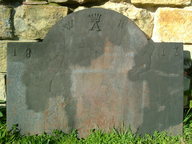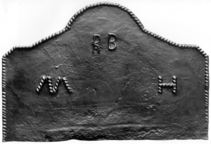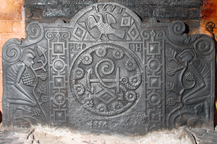-
14
Description: Arched rectangular shape; plain plate. Crowned capital ‘A’ between ‘W’ and ‘R’; divided date at top extremities of plate; single six-pointed star below ‘A’.
Notes: Earl’s coronet denotes the Earl of Ashburnham, furnace owner; ‘WR’ denotes William Rummins, furnace founder; 1813 - the furnace was blown out for the last time in late February 1813. Similar to, but narrower than the fireback at Church Farm, Penhurst (in private hands), and uses the same cipher and numbers. One of a small series of firebacks cast in the early-19th century for farms on the Ashburnham estate; this example was formerly at Great Sprays Farm, Penhurst.
Inscription: W A R / 18 * 13
- Decoration tags:
- rectangular with round arch (shape)
- none (edging)
- carved stamps
- individual letters
- individual numbers
- heraldic
- text
- objects
Manufactured: in 1813 at Ashburnham Furnace in the Weald area of England.
Current location: in private hands, Ashburnham, East Sussex, England.
- Attached to series:
- Ashburnham late series
- Date & initials firebacks
-
1024
Description: Canted rectangular shape with canted arch; probable twisted leather edging (top and sides); top centre, initials RB formed of individual carved letters; centre, widely spaced, letters M H formed of short lengths of probable twisted leather.
Notes: An unusually shaped fireback
Inscription: RB / M H
- Decoration tags:
- rectangular with canted top corners and round arch (shape)
- twisted leather (edging)
- simple stamps
- carved stamps
- individual letters
- text
Manufactured: in the early- to mid-17th century in England.
Current location: not known.
- Attached to series:
- Initials only firebacks
-
1064
Description: A rectangular field with a central circle containing a fouled anchor, the rope gathered in eleven loops around it; in the top spandrels the initials HH, on the left, and IH, on the right; below the circle, the initials IM inset in a square; on each side, a strapwork Ionic pilaster formed of alternate hollow squares, with a pyramidal infill in low relief, and hollow circles; outside each pilaster, a crouching stylised humanoid figure, facing inwards, disgorging a fructed vine; above the figures two opposed volutes, forming part of the edging; above the central field, a semi-circular compartment containing a bird, its wings inverted, and three hollow diamond shapes irregularly arranged; the date above the bird; protruding from the edging above each pilaster is a small, inward-facing scroll. Three vertical plank lines can be discerned, one in front of the right-hand figure, one through the I of the initials IH, and one to the right of the second H of the initials HH. The whole design is in low relief.
Notes: This is a reworking of a design seen on a fireback of 1608 (no. 585) though intentionally stylised. The decorative elements have yet to be fully interpreted; on the 1608 version the figures are fauns, the vines disgorged from their mouths being related to the 'green man' tradition associated with woodland spirits and symbolising resurrection, the latter echoed by the bird which, on the earlier version is a phoenix. However, in the form in which they appear on both firebacks they may be purely decorative devices. By contrast, the cabled anchor is the badge of the Lord High Admiral but in 1633 the office was vacant. The initials IM indicate that this is an early work by a prolific fireback pattern-maker more usually associated with the eastern Weald.
Inscription: 1633 / HH IH / IM
- Decoration tags:
- rectangular with round arch (shape)
- fillet (edging)
- whole carved pattern
- planklines
- pictorial
- mythological
- text
- animals
- humans
- plants
- objects
Manufactured: in 1633 in the Weald area of England.
Current location: Pound Farm, Common Road, Dunsfold, Surrey, England.
Citation: Wall, J. R. S., 20 May 1965, 'Wealden Fireback' [letter], Country Life, p. 1208.
- Attached to series:
- IM series
- Brede group


